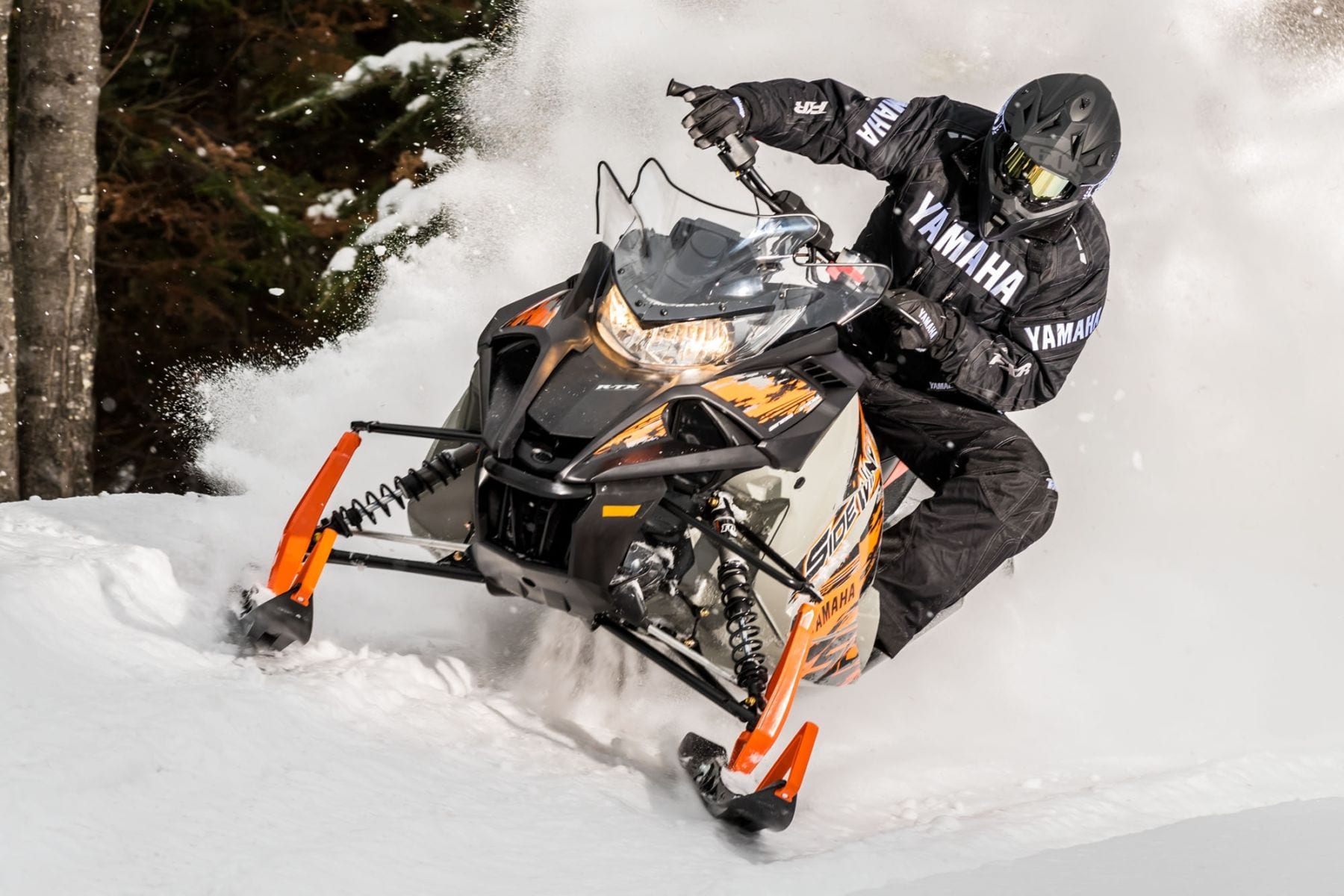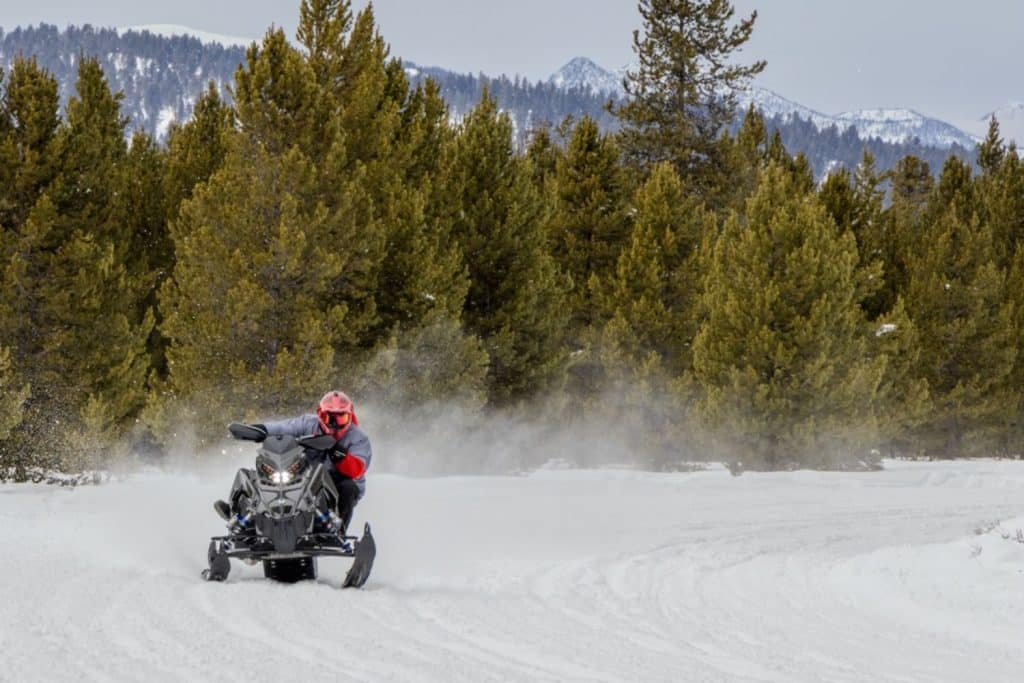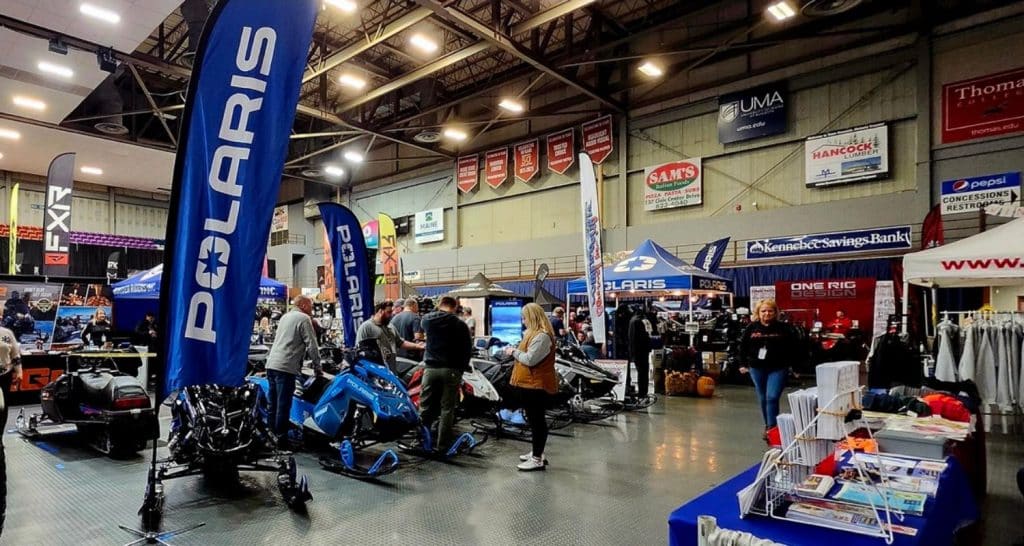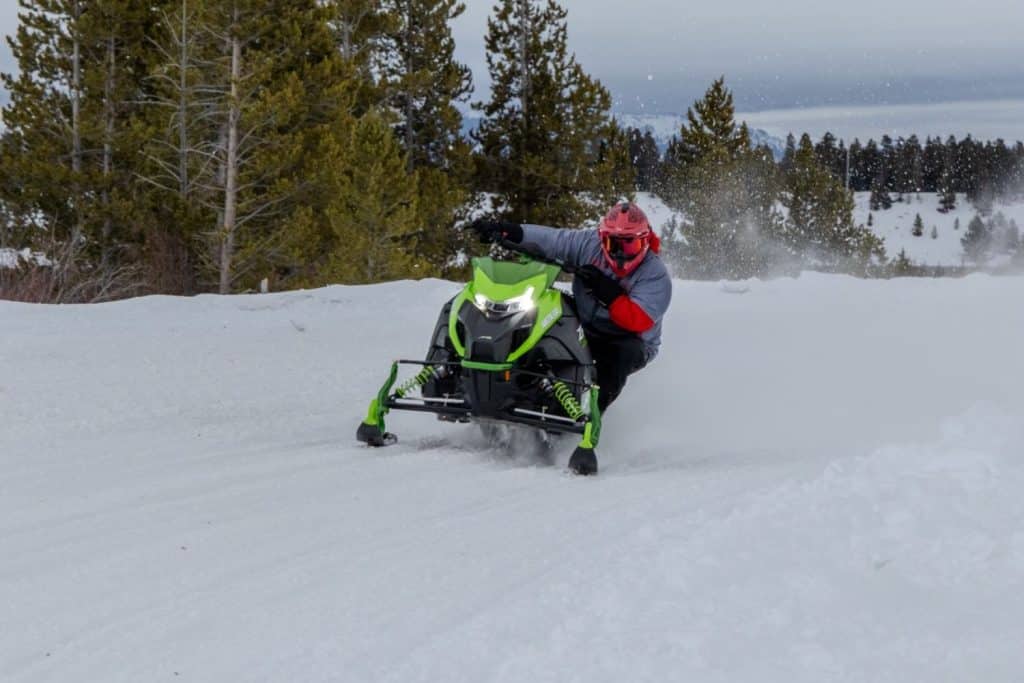2017 Yamaha Sidewinder, Yamaha has dramatically increased the level of performance with its all-new Sidewinder series of snowmobiles powered by the Genesis 998 turbocharged engine – a masterpiece of engineering.
The Sidewinder takes the lead in the 2017 crop as Yamaha’s new flagship snowmobile. It comes in R-TX, L-TX, S-TX, X-TX, M-TX and also B-TX models. The B-TX, a brand new sub-category, will please those who like to ride in remote, low-lying areas, and who prefer a 153-inch track and a narrower ski pitch than traditional deep-snow models. In addition, each B-TX features a clutch designed for sea-level riding and medium-length track bars for trail running, if needed.
Translated with www.DeepL.com/Translator (free version)
The 998T is brimming with new technologies and quality designs, including three throttle bodies that reduce hesitation to almost nothing. It’s the first production turbo engine to take advantage of this revolutionary technology, even considering the automotive industry’s engines!
A variety of options are available with each Sidewinder, including track length and suspension, to ensure that the most discerning snowmobiler has a snowmobile that is perfectly suited to their riding style and preferences.
The 2017 Yamaha snowmobile lineup is the most extensive ever, and with several new models, we’re signaling to the entire industry that Yamaha is here, ready to Conquer the Snow!
2017 YAMAHA SIDEWINDER – NEWS
2017 Yamaha Sidewinder L-TX SE
The Sidewinder L-TX SE is perfect for those who enjoy sporty trail riding and want to push the limits of their machine’s suspension. It’s equipped with high-end FOX Zero RC adjustable front amortos that perform brilliantly over cascading bumps and inhospitable terrain. The Genesis turbocharged four-stroke engine delivers power that’s the envy of rival snowmobiles, and is sure to increase your thrills. Its Ripsaw 2 track combines with Tuner 3 skis, a linked rear suspension frame and wide delta arms up front to keep this rocket flat and ensure a predictable ride as you push your limits.
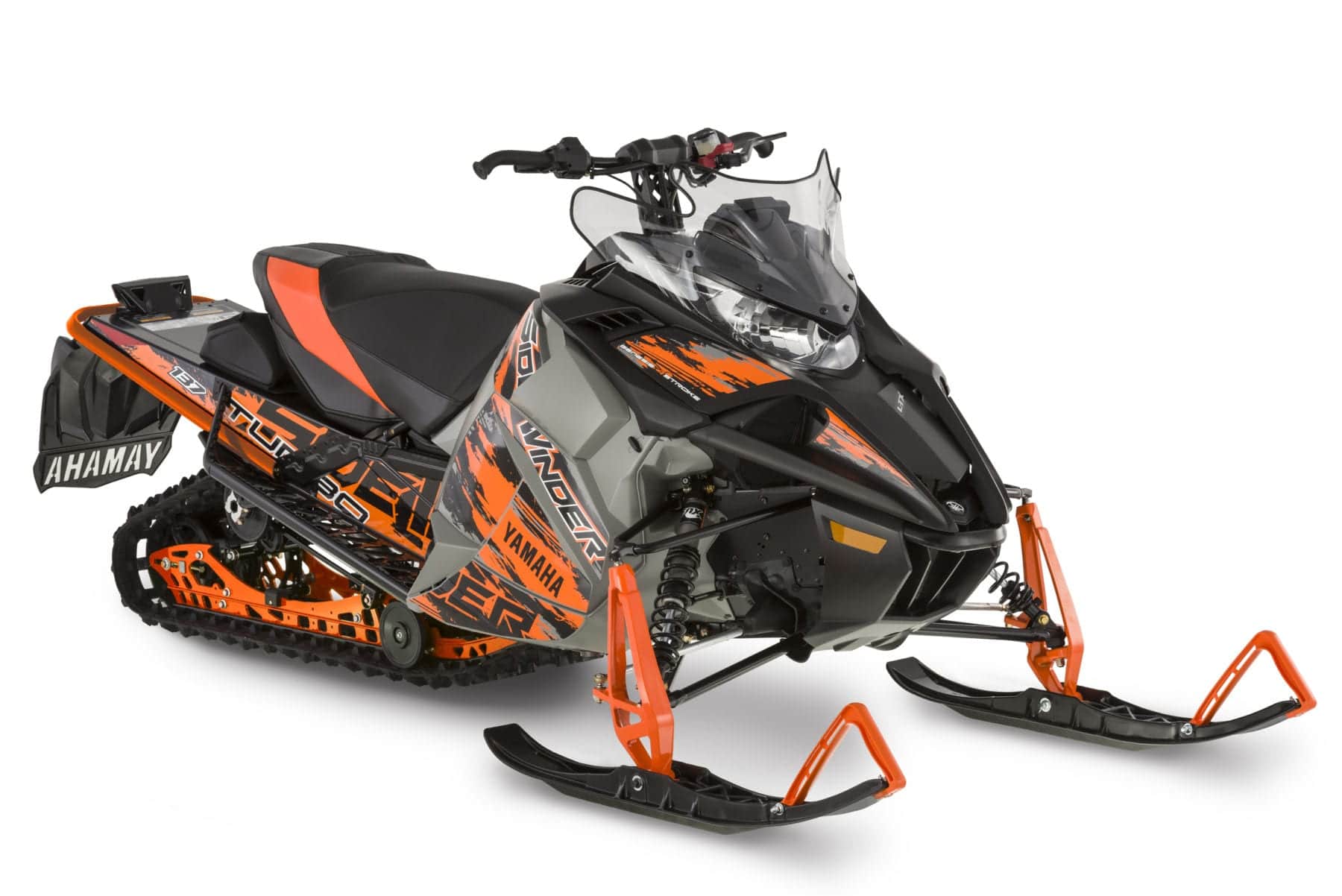
Genesis 998 Turbo 4-stroke
The Genesis 998T is powered by a supercharged Genesis three-cylinder engine. Already known for its hellish power from takeoff to top speed, this engine inherits a factory-installed turbo that allows it to set new standards in performance, while maintaining the quality, durability and reliability that make Yamaha so successful.
High quality turbocharger
The extremely robust and precise nickel alloy turbine housing can withstand very high temperatures. Supported by high quality ceramic bearings, the Inconel blades of the turbine are very strong despite their light weight.
Yamaha-Mitsubishi electronic control module
The Mitsubishi MCE developed by Yamaha takes advantage of 9 sensors to collect data on engine operating conditions and then performs calculations using a predetermined map in memory. Based on the results, it adjusts ignition timing, fuel delivery, manifold air pressure and boosted turbo pressure to maximize efficiency and reliability.
Three intake bodies
Each cylinder has its own intake manifold located as close as possible to the intake valves. This unique design provides instant acceleration when combined with the efficient turbo and air bypass system.
Air bypass valve
Unlike traditional bleed valves, the air bypass valve redirects air pressure to the intake portion of the compressor to prevent spikes and preserve turbine speed, allowing the engine to be ready to respond to the next acceleration.
Liquid-cooled turbo
The coolant circulates through the turbocharger to control the temperature. Once the engine is shut down, the convection energy produced by the coolant, which has been heated to the extreme by the turbocharger, allows it to continue to circulate without having to operate the coolant pump. The result? The engine’s cooling cycle can be eliminated, while maintaining the high durability of the turbocharger components.
Engine braking control
The “engine braking” effect associated with four-stroke engines when you stop accelerating has an impact on handling and riding pleasure. Yamaha has developed a special system that uses an idle speed control valve, electronic control module, throttle body movement and engine speed to reduce negative intake pressure during deceleration.
Aluminium cylinders
The lightweight aluminum block is coated with a ceramic composite applied directly to the cylinder wall to eliminate the need for a steel cylinder liner. This gives the cylinder excellent abrasion resistance and cooling.
Press-forged crankshaft
Our engineers used an advanced press process (press forging without twisting the metal) to provide the necessary strength to the crankshaft to withstand the additional force imposed by a supercharged engine.
High strength connecting rod
Case hardening and tempering of the connecting rod steel provides the strength required to maximize power delivery. The new connecting rods for the turbocharged engine have nut studs that join the precision-machined rod head halves. The connecting rods are also treated with a DEFRIC lubricating paint that protects during cold starts, ensuring long life and maximum reliability.
Forged pistons
The forged aluminum pistons are formed without melting the original aluminum, so they retain the strength of the solid substance, making the pistons lighter. These lightweight pistons contribute to improved acceleration and reduced vibration.
Piston cooling
The Genesis turbocharged engine has a unique piston cooling system. Oil is sprayed directly onto the underside of the pistons via special nozzles to help cool and lubricate them.
Forged camshafts
The camshaft is forged from a solid bar and then machined to its final shape. It is then heat treated, resulting in a very light and durable part, capable of sustaining very high engine speeds.
Balancing shaft
The advantage of reduced vibration comes with several benefits for both the car and the driver, including stability and reduced fatigue.
YSRC secondary roller clutch
The new reverse ramp secondary pulley has roller cam lock rollers that reduce friction, plus a special high efficiency casting that reduces aerodynamic rpm drop and temperature. The cast pulley plates are very strong, to be able to deal with the increased power. Finally, the transmission ratio is increased to accommodate a wider range of speeds and to allow the use of a smaller final gear.
Primary clutch YSRC
The new YSRC primary clutch is designed for high horsepower engines. It provides high strength, unmatched efficiency and unmatched cooling capacity.
Fuel injectionThe Genesis engine features Yamaha’s advanced fuel injection system, which precisely controls the flow of fuel to the engine for immediate acceleration and unbridled performance.
Versatile magnesium chain guard
The Sidewinder’s crankcase and chain cover both act as mounting points for the frame rails and the engine oil tank. Because they are made of magnesium, the weight is reduced.
Hayes high performance braking system
The high-performance Hayes braking system of the Sidewinder effectively brakes your speed with a large 20 cm disc. It’s mounted low on the drive shaft – you’ll feel the slowdown immediately when you pull the lever. The radial hydraulic brake master cylinder, inspired by the world of racing, multiplies the force as needed, while providing excellent feel and precise control.
15 x 137 x 1.25 inch Camoplast® RipsawMCII track
This revolutionary, lightweight track was created through the close collaboration of Yamaha and Camoplast. It features a unique ply design and a next-generation bar layout. The Ripsaw II track is designed to control side-slip, allowing the Sidewinder to move boldly through turns while keeping both skis firmly on the snow. The result: improved handling without loss of straight-line traction.
2017 Yamaha Sidewinder R-TX LE
With fully adjustable FOX QS3 Kashima amortos front and rear, the R-TX LE takes the gorgeous SE model up a notch. Its turbocharged Genesis engine features a new YSRC clutch that blends beautifully with the breathtaking power, without neglecting Yamaha’s renowned reliability. In addition to these new features, the limited edition Sidewinder also boasts a race-ready rear suspension frame, lightweight disc rotor, heated seat and low windshield. (Note: This model is available exclusively during our ‘Spring into Action’ campaign.)
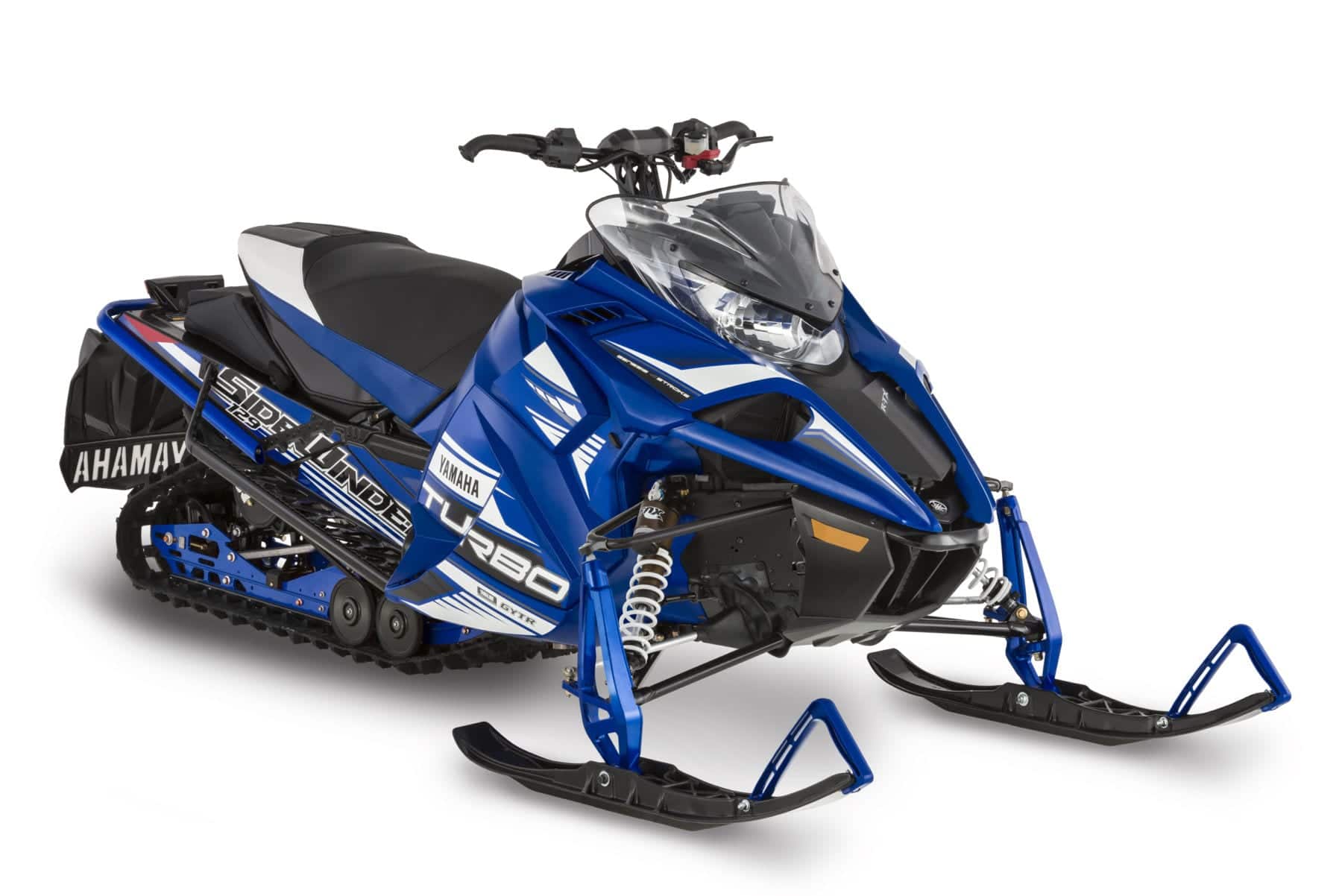
Genesis 998 Turbo 4-stroke
The Genesis 998T is powered by a supercharged Genesis three-cylinder engine. Already known for its hellish power from takeoff to top speed, this engine inherits a factory-installed turbo that allows it to set new standards in performance, while maintaining the quality, durability and reliability that make Yamaha so successful.
High quality turbocharger
The extremely robust and precise nickel alloy turbine housing can withstand very high temperatures. Supported by high quality ceramic bearings, the Inconel blades of the turbine are very strong despite their light weight.
Yamaha-Mitsubishi electronic control module
The Mitsubishi MCE developed by Yamaha takes advantage of 9 sensors to collect data on engine operating conditions and then performs calculations using a predetermined map in memory. Based on the results, it adjusts ignition timing, fuel delivery, manifold air pressure and boosted turbo pressure to maximize efficiency and reliability.
Three intake bodies
Each cylinder has its own intake manifold located as close as possible to the intake valves. This unique design provides instant acceleration when combined with the efficient turbo and air bypass system.
Air bypass valve
Unlike traditional bleed valves, the air bypass valve redirects air pressure to the intake portion of the compressor to prevent spiking and preserve turbine speed, allowing the engine to be ready to respond to the next acceleration.
Liquid-cooled turbo
The coolant circulates through the turbocharger to control the temperature. Once the engine is shut down, the convection energy produced by the coolant, which has been heated to the extreme by the turbocharger, allows it to continue to circulate without having to operate the coolant pump. The result? The engine’s cooling cycle can be eliminated, while maintaining the high durability of the turbocharger components.
Engine braking control
The “engine braking” effect associated with four-stroke engines when you stop accelerating has an impact on handling and riding pleasure. Yamaha has developed a special system that uses an idle speed control valve, electronic control module, throttle body movement and engine speed to reduce negative intake pressure during deceleration.
Aluminium cylinders
The lightweight aluminum block is coated with a ceramic composite applied directly to the cylinder wall to eliminate the need for a steel cylinder liner. This gives the cylinder excellent abrasion resistance and cooling.
Press-forged crankshaft
Our engineers used an advanced press process (press forging without twisting the metal) to provide the necessary strength to the crankshaft to withstand the additional force imposed by a supercharged engine.
High strength connecting rod
Case hardening and tempering of the connecting rod steel provides the strength required to maximize power delivery. The new connecting rods for the turbocharged engine have nut studs that join the precision-machined rod head halves. The connecting rods are also treated with a DEFRIC lubricating paint that protects during cold starts, ensuring long life and maximum reliability.
Forged pistons
The forged aluminum pistons are formed without melting the original aluminum, so they retain the strength of the solid substance, making the pistons lighter. These lightweight pistons contribute to improved acceleration and reduced vibration.
Piston cooling
The Genesis turbocharged engine has a unique piston cooling system. Oil is sprayed directly onto the underside of the pistons via special nozzles to help cool and lubricate them.
Forged camshafts
The camshaft is forged from a solid bar and then machined to its final shape. It is then heat treated, resulting in a very light and durable part, capable of sustaining very high engine speeds.
Balancing shaft
The advantage of reduced vibration comes with several benefits for both the car and the driver, including stability and reduced fatigue.
YSRC secondary roller clutch
The new reverse ramp secondary pulley has roller cam lock rollers that reduce friction, plus a special high efficiency casting that reduces aerodynamic rpm drop and temperature. The cast pulley plates are very strong, to be able to deal with the increased power. Finally, the transmission ratio is increased to accommodate a wider range of speeds and to allow the use of a smaller final gear.
Primary clutch YSRC
The new YSRC primary clutch is designed for high horsepower engines. It provides high strength, unmatched efficiency and unmatched cooling capacity.
Fuel injection
The Genesis engine features Yamaha’s advanced fuel injection system, which precisely controls the flow of fuel to the engine for immediate acceleration and unbridled performance.
Versatile magnesium chain guard
The Sidewinder’s crankcase and chain cover both act as mounting points for the frame rails and the engine oil tank. Because they are made of magnesium, the weight is reduced.
Hayes high performance braking system
The high-performance Hayes braking system on the Sidewinder effectively brakes your speed with a large 20 cm disc. It’s mounted low on the drive shaft – you’ll feel the slowdown immediately when you pull the lever. The radial hydraulic brake master cylinder, inspired by the world of racing, multiplies the force as needed, while providing excellent feel and precise control.
Camoplast® RipsawTM II 15 x 129 x 1.25 inch track
This revolutionary lightweight track was created through the close collaboration of Yamaha and Camoplast. It features a unique ply design and a next-generation bar layout. The Ripsaw II track is designed to control side slip, allowing the Sidewinder to move boldly through turns while keeping both skis firmly on the snow. The result: improved handling without loss of straight-line traction.
2017 Yamaha Sidewinder S-TX DX
The S-TX DX is sure to please the most adventurous riders. First of all, it’s equipped with the largest engine in the industry, and it’s perfectly calibrated for long days on the road. Secondly, semi-rigid saddlebags, a heated seat, a Cobra track with 1.6-inch bars and a full-size windshield maximize fun and comfort. Super-bright LED headlights illuminate the path, while the LED taillight helps keep your companions in sight. Yamaha’s new YSRC drive system bites into the snow with gusto, taking advantage of a heavy-duty V-belt for instant, precise shifting.
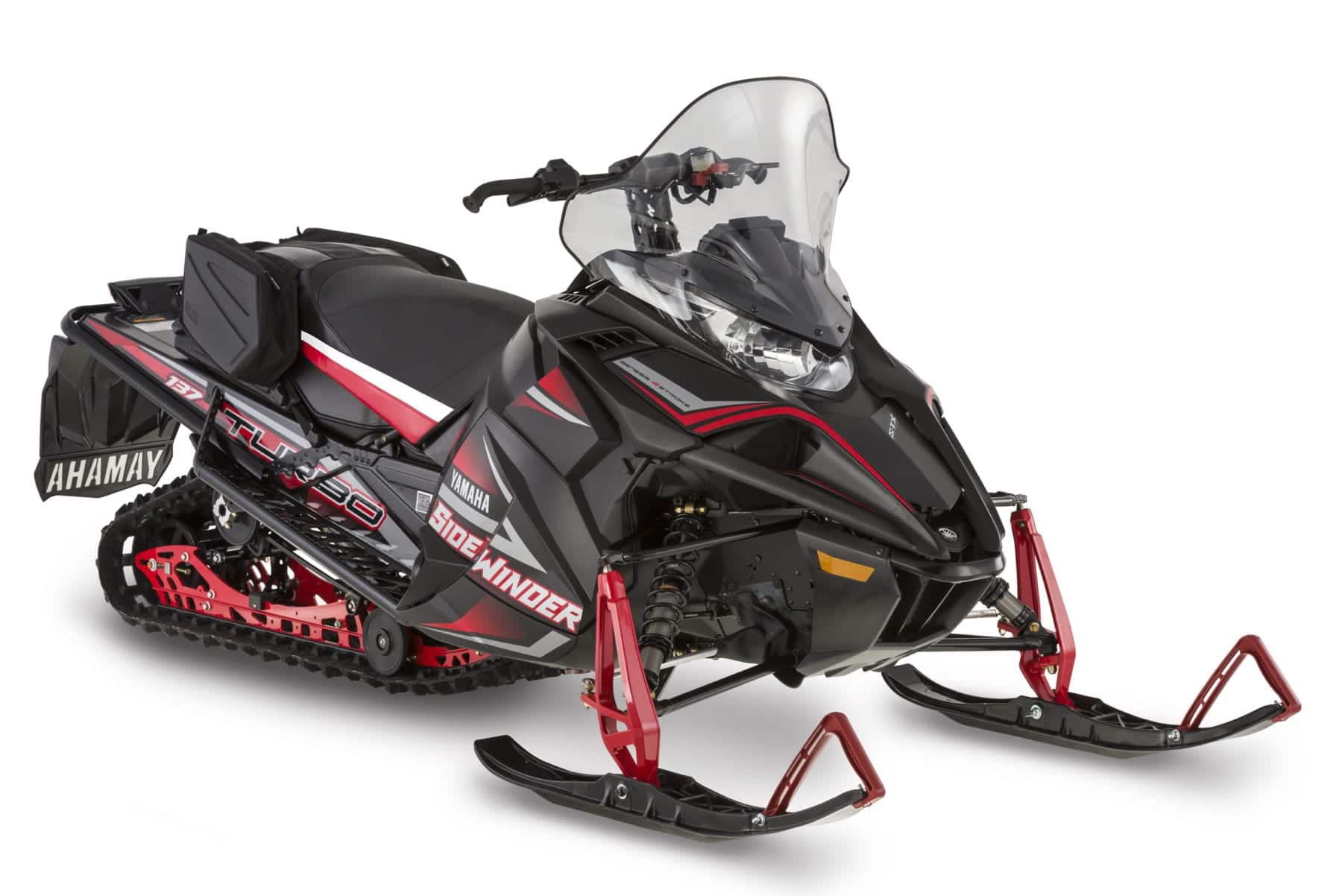
Genesis 998 Turbo 4-stroke
The Genesis 998T is powered by a supercharged Genesis three-cylinder engine. Already known for its hellish power from takeoff to top speed, this engine inherits a factory-installed turbo that allows it to set new standards in performance, while maintaining the quality, durability and reliability that make Yamaha so successful.
High quality turbocharger
The extremely robust and precise nickel alloy turbine housing can withstand very high temperatures. Supported by high quality ceramic bearings, the Inconel blades of the turbine are very strong despite their light weight.
Yamaha-Mitsubishi electronic control modulei
The Mitsubishi MCE developed by Yamaha takes advantage of 9 sensors to collect data on engine operating conditions and then performs calculations using a predetermined map in memory. Based on the results, it adjusts ignition timing, fuel delivery, manifold air pressure and boosted turbo pressure to maximize efficiency and reliability.
Three intake bodies
Each cylinder has its own intake manifold located as close as possible to the intake valves. This unique design provides instant acceleration when combined with the efficient turbo and air bypass system.
Air bypass valve
Unlike traditional bleed valves, the air bypass valve redirects air pressure to the intake portion of the compressor to prevent spiking and preserve turbine speed, allowing the engine to be ready to respond to the next acceleration.
Liquid-cooled turbe
The coolant circulates through the turbocharger to control the temperature. Once the engine is shut down, the convection energy produced by the coolant, which has been heated to the extreme by the turbocharger, allows it to continue to circulate without having to operate the coolant pump. The result? The engine’s cooling cycle can be eliminated, while maintaining the high durability of the turbocharger components.
Engine braking control
The “engine braking” effect associated with four-stroke engines when you stop accelerating has an impact on handling and riding pleasure. Yamaha has developed a special system that uses an idle speed control valve, electronic control module, throttle body movement and engine speed to reduce negative intake pressure during deceleration.
Aluminium Cylinders
The lightweight aluminum block is coated with a ceramic composite applied directly to the cylinder wall to eliminate the need for a steel cylinder liner. This gives the cylinder excellent abrasion resistance and cooling.
Press-forged crankshaft
Our engineers used an advanced press process (press forging without twisting the metal) to provide the necessary strength to the crankshaft to withstand the additional force imposed by a supercharged engine.
High strength connecting rod
Case hardening and tempering of the connecting rod steel provides the strength required to maximize power delivery. The new connecting rods for the turbocharged engine have nut studs that join the precision-machined rod head halves. The connecting rods are also treated with a DEFRIC lubricating paint that protects during cold starts, ensuring long life and maximum reliability.
Forged pistons
The forged aluminum pistons are formed without melting the original aluminum, so they retain the strength of the solid substance, making the pistons lighter. These lightweight pistons contribute to improved acceleration and reduced vibration.
Piston cooling
The Genesis turbocharged engine has a unique piston cooling system. Oil is sprayed directly onto the underside of the pistons via special nozzles to help cool and lubricate them.
Forged camshafts
The camshaft is forged from a solid bar and then machined to its final shape. It is then heat treated, resulting in a very light and durable part, capable of sustaining very high engine speeds.
Balancing shaft
The advantage of reduced vibration comes with several benefits for both the car and the driver, including stability and reduced fatigue.
YSRC secondary roller clutch
The new reverse ramp secondary pulley has roller cam lock rollers that reduce friction, plus a special high efficiency casting that reduces aerodynamic rpm drop and temperature. The cast pulley plates are very strong, to be able to deal with the increased power. Finally, the transmission ratio is increased to accommodate a wider range of speeds and to allow the use of a smaller final gear.
Embrayage primaire YSRC
Le nouvel embrayage primaire YSRC est conçu pour les moteurs haute puissance. Il fait preuve d’une grande résistance, d’une efficacité hors pair et d’une capacité de refroidissement incomparable.
Fuel injection
The Genesis engine features Yamaha’s advanced fuel injection system, which precisely controls the flow of fuel to the engine for immediate acceleration and unbridled performance.
Versatile magnesium chain guard
The Sidewinder’s crankcase and chain cover both act as mounting points for the frame rails and the engine oil tank. Because they are made of magnesium, the weight is reduced.
Hayes high performance braking system
The high-performance Hayes braking system on the Sidewinder effectively brakes your speed with a large 20 cm disc. It’s mounted low on the drive shaft – you’ll feel the slowdown immediately when you pull the lever. The radial hydraulic brake master cylinder, inspired by the world of racing, multiplies the force as needed, while providing excellent feel and precise control.
15 x 137 x 1.6 inch Camoplast Cobra track
Thicker barred track for better bite on less groomed trails. This phenomenal track also offers admirable cornering and predictable sideways skidding.
2017 Yamaha Sidewinder X-TX LE 137
The Sidewinder X-TX 137 LE is a blast in deep snow, on groomed trails and in wide-open spaces. Unlike our other X-TX models, this one retains the full 42-inch ski spread – the hallmark of trail models – and boasts a frame mated to the rear suspension to perform beautifully in the turns. In crazy snow, the 137-inch Back Country track with 1.75-inch lugs helps pull the phenomenal power of the high-performance turbocharged Genesis engine to the ground. Also, the Tuner 3 skis are teamed with FOX QS3 coil-sprung amortos that adjust in no time.
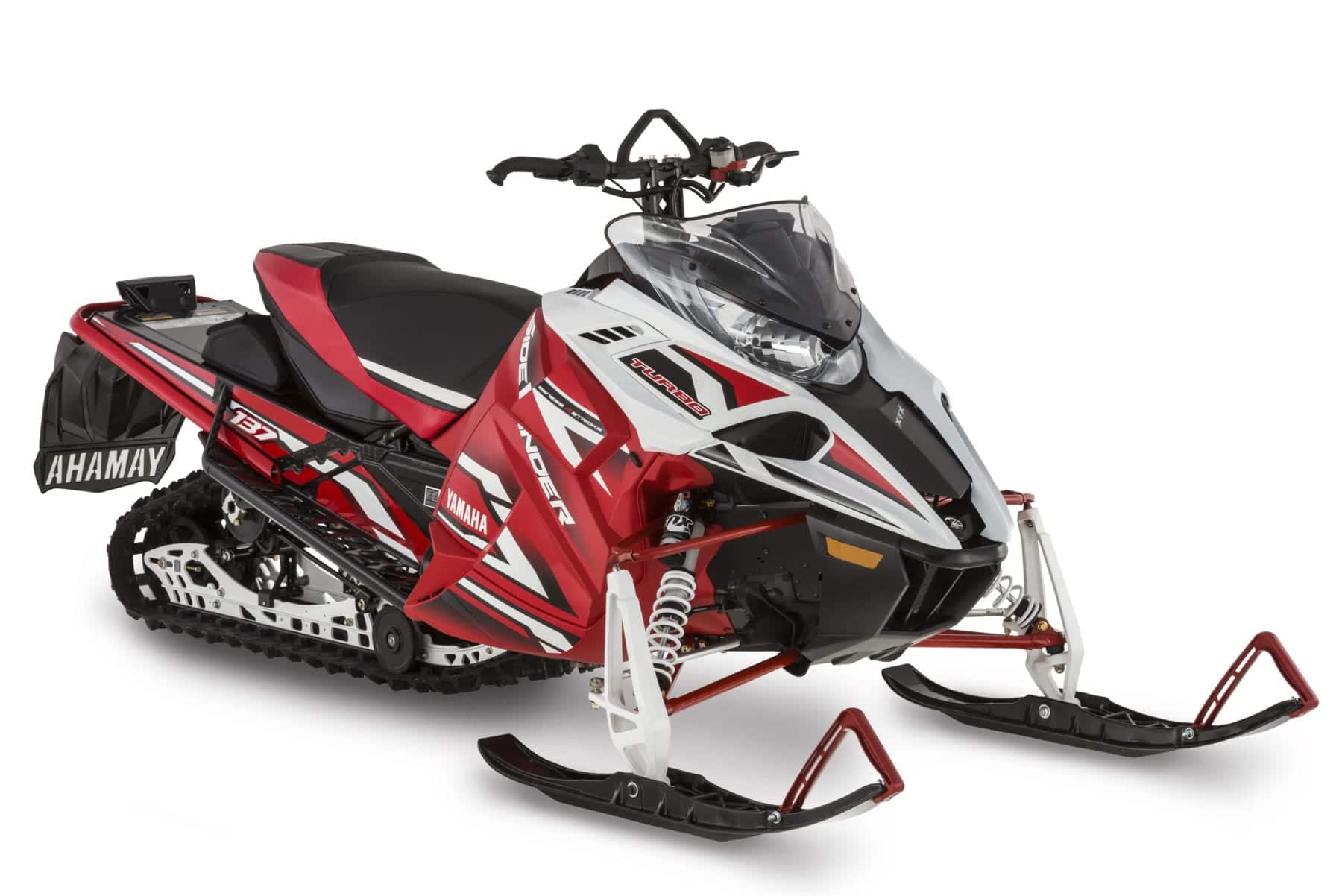
Genesis 998 Turbo 4-stroke
The Genesis 998T is powered by a supercharged Genesis three-cylinder engine. Already known for its hellish power from takeoff to top speed, this engine inherits a factory-installed turbo that allows it to set new standards in performance, while maintaining the quality, durability and reliability that make Yamaha so successful.
High quality turbocharger
The extremely robust and precise nickel alloy turbine housing can withstand very high temperatures. Supported by high quality ceramic bearings, the Inconel blades of the turbine are very strong despite their light weight.
Yamaha-Mitsubishi electronic control module
The Mitsubishi MCE developed by Yamaha takes advantage of 9 sensors to collect data on engine operating conditions and then performs calculations using a predetermined map in memory. Based on the results, it adjusts ignition timing, fuel delivery, manifold air pressure and boosted turbo pressure to maximize efficiency and reliability.
Three intake bodies
Each cylinder has its own intake manifold located as close as possible to the intake valves. This unique design provides instant acceleration when combined with the efficient turbo and air bypass system.
Air bypass valve
Unlike traditional bleed valves, the air bypass valve redirects air pressure to the intake portion of the compressor to prevent spiking and preserve turbine speed, allowing the engine to be ready to respond to the next acceleration.
Liquid-cooled turbo
The coolant circulates through the turbocharger to control the temperature. Once the engine is shut down, the convection energy produced by the coolant, which has been heated to the extreme by the turbocharger, allows it to continue to circulate without having to operate the coolant pump. The result? The engine’s cooling cycle can be eliminated, while maintaining the high durability of the turbocharger components.
Engine braking control
The “engine braking” effect associated with four-stroke engines when you stop accelerating has an impact on handling and riding pleasure. Yamaha has developed a special system that uses an idle speed control valve, electronic control module, throttle body movement and engine speed to reduce negative intake pressure during deceleration.
Aluminium Cylinders
The lightweight aluminum block is coated with a ceramic composite applied directly to the cylinder wall to eliminate the need for a steel cylinder liner. This gives the cylinder excellent abrasion resistance and cooling.
Press-forged crankshaft
Our engineers used an advanced press process (press forging without twisting the metal) to provide the necessary strength to the crankshaft to withstand the additional force imposed by a supercharged engine.
High strength connecting rod
Case hardening and tempering of the connecting rod steel provides the strength required to maximize power delivery. The new connecting rods for the turbocharged engine have nut studs that join the precision-machined rod head halves. The connecting rods are also treated with a DEFRIC lubricating paint that protects during cold starts, ensuring long life and maximum reliability.
Forged pistons
The forged aluminum pistons are formed without melting the original aluminum, so they retain the strength of the solid substance, making the pistons lighter. These lightweight pistons contribute to improved acceleration and reduced vibration.
Refroidissement des pistons
Le moteur Genesis turbocompressé a un système de refroidissement des pistons unique en son genre. De l’huile est pulvérisée directement sur le revers des pistons via des gicleurs spéciaux pour aider à les refroidir et les lubrifier.
Forged camshafts
The camshaft is forged from a solid bar and then machined to its final shape. It is then heat treated, resulting in a very light and durable part, capable of sustaining very high engine speeds.
Balancing shaft
The advantage of reduced vibration comes with several benefits for both the car and the driver, including stability and reduced fatigue.
YSRC secondary roller clutch
The new reverse ramp secondary pulley has roller cam lock rollers that reduce friction, plus a special high efficiency casting that reduces aerodynamic rpm drop and temperature. The cast pulley plates are very strong, to be able to deal with the increased power. Finally, the transmission ratio is increased to accommodate a wider range of speeds and to allow the use of a smaller final gear.
Primary clutch YSRC
The new YSRC primary clutch is designed for high horsepower engines. It provides high strength, unmatched efficiency and unmatched cooling capacity.
Fuel injection
The Genesis engine features Yamaha’s advanced fuel injection system, which precisely controls the flow of fuel to the engine for immediate acceleration and unbridled performance.
Versatile magnesium chain guard
The Sidewinder’s chain guard and cover both act as mounting points for the frame rails and the engine oil tank. Because they are made of magnesium, the weight is reduced.
Hayes high performance braking system
The high-performance Hayes braking system of the Sidewinder effectively brakes your speed with a large 20 cm disc. It’s mounted low on the drive shaft – you’ll feel the slowdown immediately when you pull the lever. The radial hydraulic brake master cylinder, inspired by the world of racing, multiplies the force as needed, while providing excellent feel and precise control.
137″ x 1.75″ x 15″ Camoplast Back Country track
This track has a reputation for being very tenacious on groomed trails and offering great flotation in deep snow. The 137 inch length is ideal for snowmobilers who get to ride regional trails with lots of snow.

2017 Yamaha Sidewinder B-TX SE 153
Any snowmobile enthusiast who travels east of the mountains will jump at the chance to ride the Sidewinder B-TX SE. It’s equipped with features normally reserved for mountain snowmobiles, including a mountain track housing, a very light rear suspension frame and mountain-friendly rockets. The skis are 40 inches apart – slightly wider than normal, and this B-TX model is calibrated for low altitudes to take advantage of every drop of juice from the new turbocharged Genesis engine. The new 153-inch Back Country track with 1.75-inch lugs offers plenty of flotation in deep snow, but performs just as well on the trail when needed. The high handlebars and mountain seat allow the rider to move around with ease, so he or she can gambol easily on the all-white carpet in the backcountry.
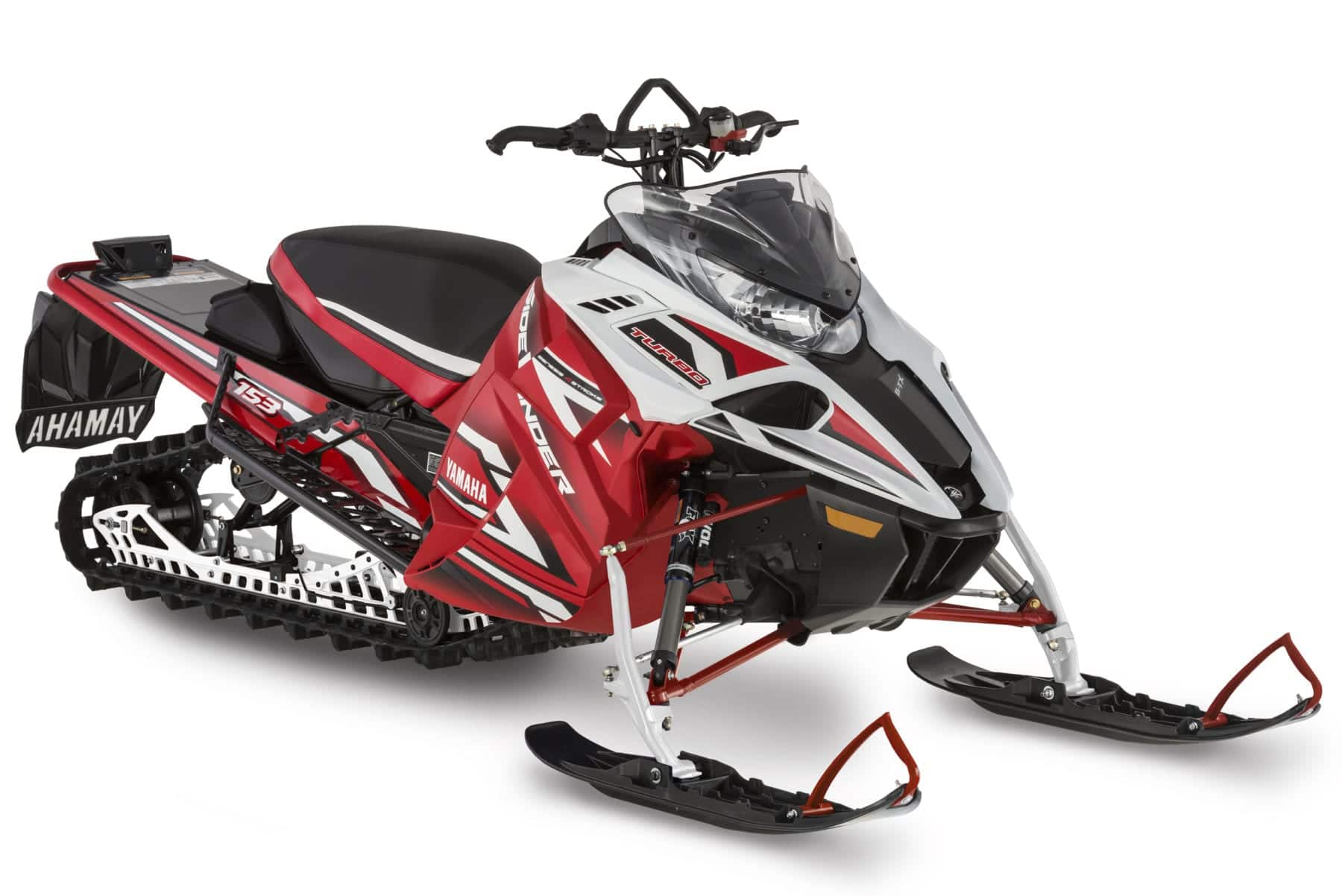
Genesis 998 Turbo 4-stroke
The Genesis 998T is powered by a gifted Genesis three-cylinder engine. Already known for its hellish power from takeoff to top speed, this engine inherits a factory-installed turbo that allows it to set new standards in performance, while maintaining the quality, durability and reliability that make Yamaha so successful.
High quality turbocharger
The extremely robust and precise nickel alloy turbine housing can withstand very high temperatures. Supported by high quality ceramic bearings, the Inconel blades of the turbine are very strong despite their light weight.
Yamaha-Mitsubishi electronic control module
The Mitsubishi MCE developed by Yamaha takes advantage of 9 sensors to collect data on engine operating conditions and then performs calculations using a predetermined map in memory. Based on the results, it adjusts ignition timing, fuel delivery, manifold air pressure and boosted turbo pressure to maximize efficiency and reliability.
Three intake bodies
Each cylinder has its own intake manifold located as close as possible to the intake valves. This unique design provides instant acceleration when combined with the efficient turbo and air bypass system.
Air bypass valve
Unlike traditional bleed valves, the air bypass valve redirects air pressure to the intake portion of the compressor to prevent spiking and preserve turbine speed, allowing the engine to be ready to respond to the next acceleration.
Liquid-cooled turbo
The coolant circulates through the turbocharger to control the temperature. Once the engine is shut down, the convection energy produced by the coolant, which has been heated to the extreme by the turbocharger, allows it to continue to circulate without having to operate the coolant pump. The result? The engine’s cooling cycle can be eliminated, while maintaining the high durability of the turbocharger components.
Engine braking control
The “engine braking” effect associated with four-stroke engines when you stop accelerating has an impact on handling and riding pleasure. Yamaha has developed a special system that uses an idle speed control valve, electronic control module, throttle body movement and engine speed to reduce negative intake pressure during deceleration.
Aluminium cylinders
The lightweight aluminum block is coated with a ceramic composite applied directly to the cylinder wall to eliminate the need for a steel cylinder liner. This gives the cylinder excellent abrasion resistance and cooling.
Press-forged crankshaft
Our engineers used an advanced press process (press forging without twisting the metal) to provide the necessary strength for the crankshaft to withstand the additional force imposed by a supercharged engine.
High strength connecting rod
Case hardening and tempering of the connecting rod steel provides the strength required to maximize power delivery. The new connecting rods for the turbocharged engine have nut studs that join the precision-machined rod head halves. The connecting rods are also treated with a DEFRIC lubricating paint that protects during cold starts, ensuring long life and maximum reliability.
Forged pistons
The forged aluminum pistons are formed without melting the original aluminum, so they retain the strength of the solid substance, making the pistons lighter. These lightweight pistons contribute to improved acceleration and reduced vibration.
Piston cooling
The Genesis turbocharged engine has a unique piston cooling system. Oil is sprayed directly onto the underside of the pistons via special nozzles to help cool and lubricate them.
Forged camshafts
The camshaft is forged from a solid bar and then machined to its final shape. It is then heat treated, resulting in a very light and durable part, capable of sustaining very high engine speeds.
balancing chamber
The advantage of reduced vibration comes with several benefits for both the car and the driver, including stability and reduced fatigue.
YSRC secondary roller clutch
The new reverse ramp secondary pulley has roller cam lock rollers that reduce friction, plus a special high efficiency casting that reduces aerodynamic rpm drop and temperature. The cast pulley plates are very strong, to be able to deal with the increased power. Finally, the transmission ratio is increased to accommodate a wider range of speeds and to allow the use of a smaller final gear.
Primary clutch YSRC
The new YSRC primary clutch is designed for high horsepower engines. It provides high strength, unmatched efficiency and unmatched cooling capacity.
Fuel Injection
The Genesis engine features Yamaha’s advanced fuel injection system, which precisely controls the flow of fuel to the engine for immediate acceleration and unbridled performance.
Versatile magnesium chain guard
The Sidewinder’s crankcase and chain cover both act as mounting points for the frame rails and the engine oil tank. Because they are made of magnesium, the weight is reduced.
Hayes high performance braking system
The high-performance Hayes braking system on the Sidewinder effectively brakes your speed with a large 20 cm disc. It’s mounted low on the drive shaft – you’ll feel the slowdown immediately when you pull the lever. The radial hydraulic brake master cylinder, inspired by the racing world, multiplies the force as needed, while providing excellent feel and precise control.
Camoplast Caterpillar Back Country 15 x 153 x 1,75
This track has a reputation for being very durable on groomed trails, while providing excellent flotation on deep snow. At 153 inches in length, it’s the ideal choice for a variety of conditions, both on the trail and in the backcountry.
For more information on the above or other models, visit: www.yamaha-motor.ca.

